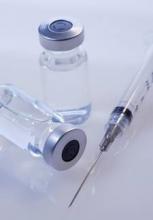Protection conferred by the hepatitis B vaccine administered in infancy continues through late adolescence, a study showed.
The low prevalence of hepatitis B in the United States and the participants’ seroprotective response to a challenge dose of hepatitis B vaccine suggest "the addition of a booster dose of hepatitis B vaccine to the routine immunization schedule for adolescents appears unnecessary," Dr. Amy Middleman of the University of Oklahoma Health Sciences Center, Oklahoma City, and her associates reported online (Pediatrics 2014;133:e1500-7).
Antibody levels of hepatitis B surface antigen (anti-HBs) of at least 10 IU/mL are considered sufficient seroprotection. Baseline anti-HBs and anti-HB core antigen (anti-HBc) were obtained from 420 adolescents aged 16-19 years, recruited in Houston between April 2010 and December 2011. All participants had received exactly 3 doses of the hepatitis B vaccine before 1 year. Those receiving it within 7 days of birth were group 1, and those receiving it at or after 4 weeks were group 2.
Participants were randomized to receive a 10-mcg or 20-mcg challenge dose of Engerix-B hepatitis B vaccine. Blood draws to determine postchallenge dose quantitative anti-HBs titer were performed 13-15 days after enrollment. Most participants (76%) had less than 10 IU/mL anti-HBs at baseline, and 92% had seroprotective levels after the challenge dose, regardless of whether they were group 1 or 2 or received the 10-mcg or 20-mcg doses.
"Importantly, immune memory remained intact for most subjects, despite evidence elsewhere that the infant immune system has a diminished capacity to mount a robust response to the primary vaccination series," the authors reported.
Geometric mean titers following the challenge dose were higher in group 2 (1,745.77) than in group 1 (487.84) and among those receiving 20 mcg (1,314.67) than among those receiving the 10-mcg (537.65) dosage. Higher baseline anti-HBs titer and being nonwhite were associated with higher geometric mean titers. Marijuana smokers receiving the higher challenge dose had a blunted response. No participants were anti-HBc positive, and no adverse events were reported following the challenge dose. The hepatitis B vaccine between 1991 and 1998 was 2.5 mcg per dose, but is now 5 mcg or 10 mcg.
The study was supported by the Centers for Disease Control and Prevention. Dr. Middleman’s institution receives Novartis grant funds. Dr. Baker has served on an advisory board for Pfizer and has consulted for and served on an advisory board for Novartis Vaccines.


